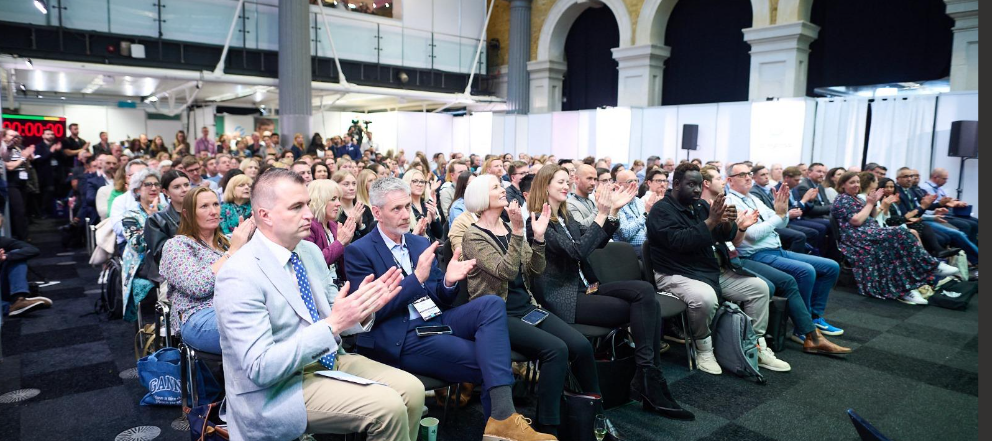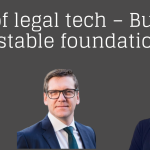We bring together some of the key findings from the conference chairs and other attendees of the British Legal Technology Forum 2024
Exactly a week ago, on 14 May, the doors opened to the British Legal Technology Forum conference, which saw around 1,500 people attend, with Louis Theroux rounding off the day as the final keynote.

Reflecting on the day, overall chairman professor Richard Susskind told Legal IT Insider: “By a margin, I felt this was the best run of the BLTF that we have had. There was a great buzz in the place.” He added: “I think the remarkable recent advances in AI have injected a new wave of energy and enthusiasm into the legal technology community.”
While AI was the enduring theme of the day, Susskind and others spent the day cautioning delegates that we are still at the foothills of AI in law. He told us: “In my opening comments as chair of the conference, I said that I felt most of the current predictions being made by enthusiasts about the short-term impact of AI on the law were greatly overstating its likely impact. However, and more importantly, I said that most of the long-term predictions (2030 and beyond) are hugely understating impact which in my view will be pervasive, irreversible and profound change to the practice of law and the administration of justice.”
Susskind, who also led the Egress main stage, interviewed Theroux in the closing session and said: “He was characteristically funny and insightful. I hope our discussion will encourage legal technologists to look for inspiration and ideas beyond our community. We can learn a lot from people looking in on legaltech from the outside.”
Each of the four main stages had a different chair and on the FutureTech Stage was Jenifer Swallow, a lawyer and technology adviser who was previously director of LawtechUK, who in a LinkedIn post following the event summarised the sessions as follows:
– The froth of generative AI excitement has settled and we are well into the hard yards of use cases.
– Many insights were redolent of common scaling problems inside tech companies – nothing new as such, but for the application in law.
– After years of 1% gains from legal tech deployment, we are starting to realise 50% plus gains and measurable ROI. It’s not hard to see how we can move in leaps and bounds, when building and blending tech in-house is now so accessible (hint: hire a dev).
– Clients want and need that change. Demand is no longer only from in-house teams but from boards. – Corporate law firms are en masse worried about their business model. How do you charge for tools that replace fee earner time; what happens when you make accessible all the advice you’ve ever given; will clients in future go direct to tech vendors for their legal services; what will the real differentiator be…?
– Virtual and mixed reality might be out of the limelight but their capabilities are significant and their hype star will rise again. Same goes for other technologies like quantum, IOT and DLT. Blending these techs presents practical opportunities, including around user experience, data integrity and security.
– Loud and clear on the criticality of governance, ethics and controls, with novelty itself as an ongoing risk, given the pace of development of the underlying technologies. Interesting to hear approaches and attitudes to mitigations, including to de-risk the IP threat to open LLMs.
-~60% of UK citizens are concerned about certain uses of AI. A software system was at the heart of The Post Office Scandal. If there is any profession that needs to take responsibility to heart in how we deploy, it’s the legal profession.
Legal IT Insider hosted a panel on the FutureTech stage with Addleshaw Goddard’s head of innovation and legal technology operations, Elliot White; crypto expert Erica Stanford, who is on the generative AI committee at CMS; and InterAlia Consulting founder Andrea Miskolczi, who was previously Europe director of innovation at Dentons. All three panelists have been involved in the consideration, selection and roll out of technologies including Spellbook, Microsoft Copilot and Thomson Reuters CoCounsel. The key points included (thanks to Miskolczi’s LinkedIn post):
- Initial enthusiasm is giving way to hard work – managing data and knowledge and (re)designing processes;
- Fostering change and adoption bring real value to firms and their clients;
- AI transformation is a topic in most boardrooms, although in some it remains a question of technology and efficiency rather than a strategic trend reshaping industries, markets and business models;
- While being the first might not have been important for all firms, being the last is to be avoided;
- The firms and legal teams leveraging generative AI strategically and purposefully are gaining significant competitive advantage.
Also commenting on the panel LinkedIn, Stanford said: “It was great to speak about how law firms are using Gen AI, about all the tools we’re using, where we’re saving time, where we’re saving money (and not), some of the changes law firms are seeing and will soon see and what we’re doing at CMS UK.”

Also speaking on a panel on the FutureTech stage was Charles Russell Speechly’s director of innovation Joe Cohen, who was on a ‘Buy, Build, Both or Integrate’ panel with Shawn Curran, director of legal technology at Travers Smith; Jackson Staub, data &. AI practice manager (EMEA) at Insight; and Swallow herself
On LinkedIn, Cohen summarised the points he made as follows:
1) law firms are fast becoming builders instead of buyers (although as Shawn would say, is calling the GPT4 API *actually* building or is it really just buying further down the value chain – fair point). Either way, in this landscape, the value of a developer or two I believe is higher than ever: by leveraging Gen AI APIs with a small-ish layer on top one developer can probably build ~five ‘80%’ solutions a year for the price of one off-the-shelf product annual license fee. The power of the LLMs is essentially quite democratising ????
2) OK but law firms will still be buying right? Yes, sure. However for me there are three things to look for in a tech product – if it’s lacking all three then you might consider ‘building’ the use case yourself, otherwise there is a buy opportunity:
a) data. If the product is primarily based on an important dataset that you don’t have access to (eg PLC or Lexis) and/or cannot replicate then buying is an option
b) interface/architecture. If the tool leverages LLMs in a non-trivial fashion, or there is a particular process architecture that you don’t have experience in, then this is also a buy opportunity. Many products will say that they sit in this category, so you will need to decide whether you need the 100% solution or whether an 80% one will do (if it’s possible for you to build at all). Examples here could be eDisclosure platforms or tools that are heavily visual.
c) expertise. If there is a particular knowledge set (document, process or mix of both) that you don’t have, and would have to hire in, that is another buy opportunity. This is where I see law firms (like us ????) positioning their own software
The Deazy innovation stage was led by Pinsent Masons’ head of cyber professional services, international, Christian Toon, focusing on new systems, processes and solutions. Toon’s key takeaways were:
– The landscape is undoubtedly undergoing a transformative shift driven by AI & emerging technologies. However, the crux of the matter lies not in the change itself but in the pace at which law firms embrace & adapt to these new paradigms. The legal profession, long known for its adherence to tradition, is now confronted with the pressing need to accelerate its evolution & align its operations with the rapidly advancing technological age. This paradigm shift, akin to the industrial, information, & knowledge revolutions, necessitates a fundamental rethinking of how law firms operate. Sarah Harris insight was great to hear.
– Amidst the excitement surrounding AI, a resounding message echoed the importance of prioritising information architecture (IA) before diving into artificial intelligence. Ensuring robust data quality & structure is paramount for leveraging AI effectively. As Amir Mehdi referenced again “IA before AI” – a concept that really resonated with me.
– Awesome quotes from ????Ian Hawkins resonated profoundly, reminding us to “be fearless, not stupid” when considering AI for our organisations. Additionally, his caution that AI outputs can be “complete bullshit, but entirely plausible” underscored the need for critical evaluation & responsible oversight.
– Someone confirmed iManage now has Office 365 plugin, this piqued my interest. Hoping it can unify data & information management silos in law firms relying on this platform others. This integration could potentially streamline legal operations so warrants further research.
– A resounding theme emerged: Business Transformation is not merely a desired outcome but a skill & approach in itself. Successful transformations hinge on having the right teams & leadership in place, a factor that cannot be overlooked in the pursuit of organizational excellence. Adam Marsland shared some great insight.
– Amidst the enthusiasm for AI, a sobering reminder surfaced – AI can amplify the consequences of flawed legal frameworks, making bad law worse. Conversely, it can also elevate well-crafted legislation, making good law great. This duality underscores the imperative of responsible stewardship in AI’s adoption & application in the legal sector.
– Cultivating the right tone, talent & fostering a people-centric approach is paramount for any successful law firm transformation, including the integration of AI & emerging technologies in law.
And the Iron Mountain stage was chaired by Christina Blacklaws, managing director of Blacklaws Consulting and former president of the Law Society of England and Wales, who told Legal IT Insider that just a few of the key takeaways from her diverse array of panels on subjects from digital lawyers to data were:
– The changes in decision making are essentially what are going to future proof the firm;
– The necessity of communication and focusing on people: the skillset coming through is huge but we have to give importance to the human element as more technology strips away direct human interaction;
– Ethical considerations should be prioritised to build a culture of trust and sustainability in your organisation.
Thomson Reuters had its own fifth stage where interviews included a fireside chat with Jamie Windsor, client solutions assistant manager at Foot Anstey amid a range of senior Thomson Reuters executives.
Legal IT Insider was the official BLTF media partner, and we had a dedicated media lounge at the Old Billingsgate venue, which meant a full day on camera, chatting with legal tech leaders from law firms, corporate legal, and vendors across the spectrum. Those videos will be available very shortly.


It has taken us a week to recover and get through the feedback on BLTF, which always attracts a very senior crowd of CIOs among others, and is a great networking opportunity. Thanks to BLTF hosts Netlaw Media, and in particular CEO Frances Anderson, for hosting a fabulous event.
Here are some photos from the event.













